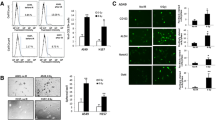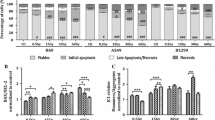Phenotypic characteristics of human non-small cell lung cancer cells, A549 (p53 wild-type) and H1299 (p53-deficient) as well as their descendants surviving after multifraction X-ray irradiation at a cumulative dose of 60 Gy (sublines A549HR and H1299HR, respectively) were studied before and after additional 2 Gy single dose irradiation. In 24 h after the additional irradiation, we observed a significant increase in the proportion of cells with signs of entosis (by 5 times, p<0.05) and SA-β-gal+ cells (by 1.6 times, p<0.01) in the general population of A549HR cells. In contrast, a significant increase in the proportion of only SA-β-gal+ multinucleated giant cancer cells was revealed in the parental A549 cells. Additional single dose irradiation resulted in a significant (by 1.8 times, p<0.05) increase in the proportion of multinucleated giant cancer cells in H1299HR cells in comparison with their parental H1299 cells. These changes did not correlate with changes in the proportion of entotic cells, because their high basal content in the absence of functional p53 did not change in response to additional single dose irradiation. At the same time, both p53-deficient non-small cell lung cancer cell lines showed a significant (2.9-fold for H1299 and 5.5-fold for H1299HR cells, p<0.001) increase in the proportion of SA-β-gal+ cells in the general population, but not in the multinucleated giant cancer cells population.
Similar content being viewed by others
References
Mirzayans R, Andrais B, Murray D. Roles of polyploid/multinucleated giant cancer cells in metastasis and disease relapse following anticancer treatment. Cancers (Basel). 2018;10(4):118. doi: https://doi.org/10.3390/cancers10040118
Kanazawa H, Mitomi H, Nishiyama Y, Kishimoto I, Fukui N, Nakamura T, Watanabe M. Tumour budding at invasive margins and outcome in colorectal cancer. Colorectal Dis. 2008;10(1):41-47. doi: https://doi.org/10.1111/j.1463-1318.2007.01240.x
Zhang S, Mercado-Uribe I, Xing Z, Sun B, Kuang J, Liu J. Generation of cancer stem-like cells through the formation of polyploid giant cancer cells. Oncogene. 2014;33(1):116-128. doi: https://doi.org/10.1038/onc.2013.96
Krajcovic M, Johnson NB, Sun Q, Normand G, Hoover N, Yao E, Richardson AL, King RW, Cibas ES, Schnitt SJ, Brugge JS, Overholtzer M. A non-genetic route to aneuploidy in human cancers. Nat. Cell Biol. 2011;13(3):324-330. doi: https://doi.org/10.1038/ncb2174
Shu Z, Row S, Deng WM. Endoreplication: the good, the bad, and the ugly. Trends Cell Biol. 2018;28(6):465-474. doi: https://doi.org/10.1016/j.tcb.2018.02.006
Overholtzer M, Mailleux AA, Mouneimne G, Normand G, Schnitt SJ, King RW, Cibas ES, Brugge JS. A nonapoptotic cell death process, entosis, that occurs by cell-in-cell invasion. Cell. 2007;131(5):966-979. doi: https://doi.org/10.1016/j.cell.2007.10.040
Alhaddad L, Pustovalova M, Blokhina T, Chuprov-Netochin R, Osipov AN, Leonov S. IR-surviving NSCLC cells exhibit different patterns of molecular and cellular reactions relating to the multifraction irradiation regimen and p53-family proteins expression. Cancers (Basel). 2021;13(11):2669. doi: https://doi.org/10.3390/cancers13112669
Zorin V, Zorina A, Smetanina N, Kopnin P, Ozerov IV, Leonov S, Isaev A, Klokov D, Osipov AN. Diffuse colonies of human skin fibroblasts in relation to cellular senescence and proliferation. Aging (Albany NY). 2017;9(5):1404-1413. doi: https://doi.org/10.18632/aging.101240
Sharma N, Dey P. Cell cannibalism and cancer. Diagn. Cytopathol. 2011;39(3):229-233. doi: https://doi.org/10.1002/dc.21402
Author information
Authors and Affiliations
Corresponding author
Additional information
Translated from Byulleten’ Eksperimental’noi Biologii i Meditsiny, Vol. 174, No. 7, pp. 89-93, July, 2022
Rights and permissions
Springer Nature or its licensor (e.g. a society or other partner) holds exclusive rights to this article under a publishing agreement with the author(s) or other rightsholder(s); author self-archiving of the accepted manuscript version of this article is solely governed by the terms of such publishing agreement and applicable law.
About this article
Cite this article
Pustovalova, M.V., Yashkina, E.I., Alhaddad, L. et al. Phenotypic Characteristics of Dormant Human Non-Small Cell Lung Cancer Cells Surviving Multifraction X-Ray Irradiation. Bull Exp Biol Med 174, 76–80 (2022). https://doi.org/10.1007/s10517-022-05652-7
Received:
Published:
Issue Date:
DOI: https://doi.org/10.1007/s10517-022-05652-7




